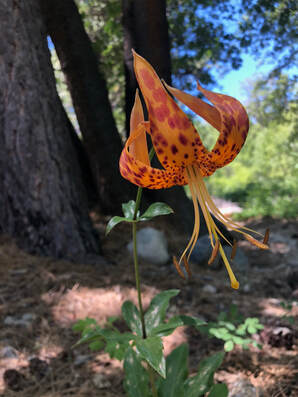 Humboldt lily on the banks of Deep Creek Humboldt lily on the banks of Deep Creek This past weekend we (my hiking buddy Allison Hansen and I) hiked a ~27 mile section of the PCT spanning from Little Bear Spring Camp to where the trail intersects with Highway 173 near the Mohave River Dam and Reservoir. This hike felt like a big deal for both of us because it's the first backpacking trip we've been on since my rattlesnake (Crotalus ruber) bite back in April, which put me in the hospital for a few days and decommissioned me from hiking for several months. We didn't see any rattlesnakes on this hike but that certainly wasn't because we weren't looking; I've never scanned the trail sides so carefully. I wouldn't say I'm afraid of rattlesnakes, in fact I wanted to see one (from afar), I just have a healthy respect for them and don't want to repeat the same gaffe of rudely stepping on one when it's just trying to move around within their habitat. On Saturday, we hiked about 13 miles in and camped on the banks of Deep Creek near the footbridge. This part of the trail winds along Holcomb Creek and crosses over it at multiple points, so a lot of the trail is shaded riparian area with the lots of fresh water to filter and drink. A highlight of the day was seeing several queens of the soon-to-be state-listed Crotch's bumble bee (B. crotchii). They were all foraging on a leguminous plant alongside workers of another bumble bee species (B. vosnesenskii, the most common species in most of California) and, unfortunately, honey bees. These honey bees are either living feral in the National Forest or are coming from hives placed in or near the Forest. Honey bees really don't belong in our wildlands; they are non-native and spread disease and remove food resources, including in areas where this food is desperately needed by wild bees. It's particularly sad to see them in a place where the threatened B. crotchii appears to be doing relatively well. That night, we set up camp in a beautiful spot and watched jumping trout try to catch mayflies while we cooked dinner. We also saw B. vosnesesnkii workers on the banks of the creek, licking the gritty sandbank, probably to obtain nutrients. This is something I've seen bumble bees do in several places now, including up in northern Alaska. On Sunday we hiked ~16 miles out. Despite winding along Deep Creek for most the section, this part of the trail is much more exposed and not something I would recommend in July. I was experiencing heat stress as we got later into the day and was ready to wrap things up by the time we reached our pickup, which isn't usually the case. I also saw no bumble bees along this part of the trail as it begins to feel a lot more like the low desert of the Mohave, which isn't hospitable for bumble bees. Allison and I were both saddened to see increasing levels of trash as we neared the areas where there is more human activity, and a highlight of the day, reaching a swimming hole and hot spring around a bend in Deep Creek, was dampened by seeing lose dogs, trash, and human waste near the banks. This was a perfect hike for me to push my limits a bit (especially with respect to heat) and reassure myself that my foot is healed and ready for long distances. The mountains around Riverside are so beautiful and home to so many amazing critters and plants. I'm so glad to be back out in the wildlands.
0 Comments
Your comment will be posted after it is approved.
Leave a Reply. |
 RSS Feed
RSS Feed